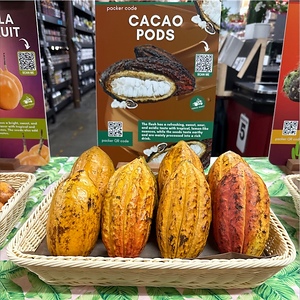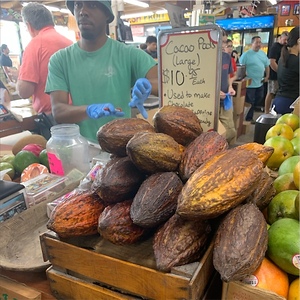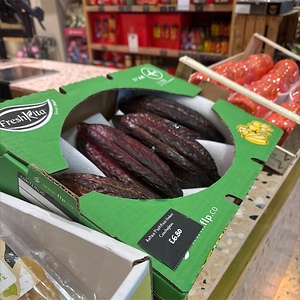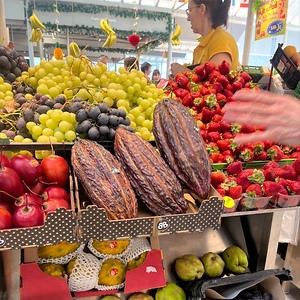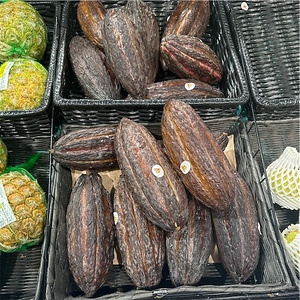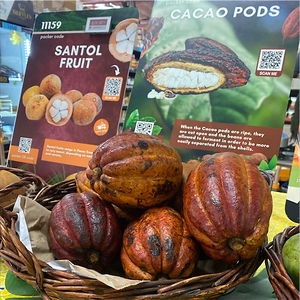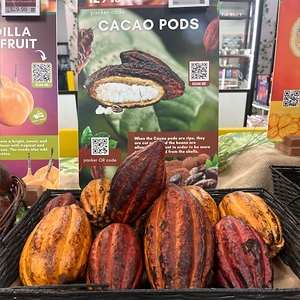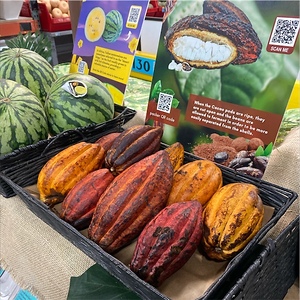


Cacao Pods
Estimated Inventory, lb : 0
This item was last sold on : 05/10/25
Description/Taste
Cacao pods range from medium to large in size, averaging 10 to 35 centimeters in length, depending on the specific variety, and generally have an oblong, tapered appearance with blunt to pointed ends. There are many different types of Cacao with varying characteristics, and the husk is typically dense, covered in pronounced ridges, creases, and warts. The rind also ranges in color from red, yellow, orange to purple and has a leathery and woody consistency when opened. Underneath the husk is 20 to 60 tightly packed, elongated seeds encased in a fleshy pulp. The white pulp has a soft, slippery, aqueous, and mucilaginous mouthfeel and is adhered to a dark brown central seed. The seeds have a drier, dense, and chewy consistency. The seeds will loosen from the husk once ripe, and the pod can be gently tapped or shaken to listen for this movement. The pods can also be lightly scraped. If the scratched surface is green, the pod is not ripe. The pulp and seeds of Cacao pods are edible, but their flavor will vary depending on the region, variety, and cultivation method. Opened pods will release an astringent, faintly floral aroma. The pulp will generally have a fruity, tangy, acidic, and subtly sweet flavor with varied faint nuances of pineapple, citrus, lychee, or mango. It is important to note that some varieties are sweeter than others, and some Cacao pulp can taste astringent. The seeds are also edible but carry a bitter and earthy flavor, which is generally considered unpleasant when raw.
Seasons/Availability
Cacao pods are available year-round.
Current Facts
Cacao pods, botanically classified as Theobroma cacao, are colorful husks encasing edible flesh and seeds found on evergreen trees belonging to the Malvaceae family. The tropical trees are native to South America, averaging twelve meters in height, and can live to be more than two hundred years old. Cacao pods grow directly from the trunks of the tree and are generally produced throughout the tree's first thirty years. Worldwide, there are more than eleven identifiable varieties of Cacao pods created from generations of natural cross-pollination. Still, most scientists simplify the species into groups under the names Criollo, Nacional, Forastero, and Trinitaro. Each variety of Cacao will have a distinct flavor and appearance, and the taste is primarily determined by the weather, soil type, region, and cultivation process. The traditional uses of Cacao stem from an ancient, complex history filled with legends, politics, the divine, and bloodshed, and the seeds have been revered as a gift from the gods for thousands of years. The scientific name for the species, Theobroma, even translates to mean "food of the gods." In the modern day, Cacao pods are cultivated worldwide for their seeds and flesh and are used to make one of the most famous sweets in history: chocolate.
Nutritional Value
Cacao seeds and flesh are a source of fiber to regulate the digestive tract, magnesium to control optimal nerve functioning, and potassium to balance fluid levels within the body. Cacao also provides some vitamin E to protect the skin while guarding against the damage caused by free radicals, iron to develop the protein hemoglobin for oxygen transport through the bloodstream, vitamin D to help the body absorb calcium, and other nutrients, including antioxidants, B vitamins, and tannins. In addition to vitamins and minerals, processing Cacao results in a product known as cocoa butter, an ingredient commonly found in lotions and cosmetics to nourish the skin.
Applications
Cacao seeds and their surrounding flesh are the edible portions of the pod and can be eaten raw or processed. When raw, the flesh and seeds can be chewed together, but the seeds are typically very bitter and astringent. Most consumers choose to only suck on the soft, white pulp and discard the seed. The raw seeds can be blended into smoothies if they are combined with sweeter ingredients to create a more palatable flavor. The most common Cacao preparation method is processing the seeds and flesh. The pods are traditionally cut open, dropping the flesh-covered seeds into a covered container. The seeds are left to ferment for 2 to 8 days, and once fermented, they are placed in the sun to dry. Dried Cacao seeds are then roasted for 5 to 40 minutes, and the length of time for which the seeds are roasted will alter the seed's flavor. Once roasted, the seeds are winnowed to remove their tough husks, leaving small edible pieces known as Cacao nibs. Cacao nibs can be gently crushed into smaller pieces and sprinkled over granola, yogurt, chia seed pudding, oatmeal, or ice cream. Cacao nibs can also be ground into a powder known as cocoa. Cocoa powder is famously used in flavoring baked goods such as cakes, cookies, bread, and fillings. It can also be mixed into beverages such as hot chocolate, stirred into stews, chilis, and sauces, or used as a dry rub for meats such as beef or pork. Beyond powder, processed Cacao is the central ingredient in chocolate. In Ancient Central American civilizations, Cacao seeds were fermented, roasted, and ground into a paste. This paste was mixed with water to make a beverage and was flavored with spices, chile peppers, honey, or corn, poured between cups to develop a thick foam. This beverage was known among the Aztecs as xocolatl, a Nahuatl word meaning "bitter drink" or "bitter water." This word later inspired the name chocolate. Cacao seeds are highly perishable and should be quickly consumed for the best quality and flavor. If not consumed raw, they are immediately processed.
Ethnic/Cultural Info
Legend has it that Cacao pods were introduced to the Toltec civilization by Quetzalcoatl, the god of wisdom and fertility. Quetzalcoatl often appeared as a feathered serpent, bearing a half human and half snake body with the wings of a bird. One day Quetzalcoatl stole a Cacao pod from the garden of the gods, planting the seeds on Earth as a gift to the Toltec people. The seeds sprouted into a beautiful tree, and the colorful pods provided seeds that would give the people life-giving energy, encouraging them to work harder and expand their knowledge. The Toltec people built temples dedicated to Quetzalcoatl out of thanks for the divine Cacao pods, and the seeds were typically crushed into a paste and drunk as a stimulant. After hearing of the stolen Cacao pod, the gods were angry and disguised themselves as magicians, convincing Quetzalcoatl to drink an unknown beverage laced with poison. The drink caused Quetzalcoatl to become delusional, leading him to destroy villages and Cacao trees. Once Querzacoatl realized what he had done, he retreated into the jungle, scattering the last few remaining Cacao seeds among the trees, and died, sending fiery red birds into the sky from his ashes. Over time, the legend of Quetzalcoatl lived on among ancient storytellers and was eventually passed from the Toltecs to the Aztecs. Each year, the tale of Quetzalcoatl and Cacao was recited among the Aztecs in hopes that Quetzalcoatl would one day come back to life and return to his people.
Geography/History
Cacao trees are believed by experts to be native to regions of the Amazon rainforest in South America. The exact site of origin is unknown, but the trees typically appear within 15 to 20 degrees of the equator, an area sometimes known as the "cocoa belt." Cacao trees thrive in semi-shady, tropical regions, often in the shadows of other trees in lowlands. Over time, the pods were carried into Central America and Mexico, where they were planted and cultivated throughout the Toltec, Mayan, Aztec, and Olmec Civilizations. Cacao was revered as a god-given plant and was heavily protected and reserved for ceremonial and religious uses. One of the oldest records of Cacao being fermented into a drink was a small amount of Cacao residue found on pottery dating back to 1400 BCE. In the 16th century CE, Spanish explorers under the leadership of conquistador Hernando Cortes encountered Cacao pods for the first time when they ventured into the Aztec city of Tenochtitlan. Aztec leader Montezuma offered Cortes a Cacao-based drink, and though the explorers disliked the beverage, they carried the pods back to Spain, introducing Cacao to Europe. Cacao seeds became one of the essential commodities that Spain had acquired from Mexico. The seeds were initially reserved as a drink for nobility and the wealthy in Europe in the 17th century, but by the 19th century, the seeds spread throughout the continent, where they were processed and mixed with sweetener to make chocolate bars. The Portuguese also planted Cacao in Africa in the 17th century, especially in West Africa. Today countries in Africa are the largest producers of Cacao, followed by regions in Brazil, Ecuador, the Dominican Republic, Papua New Guinea, and Indonesia.
Recipe Ideas
Recipes that include Cacao Pods. One
| Dandelion Chocolate |
|
Preparing Fresh Cacao Pods |
| Cooking Therapy |
|
Hawaiian Bliss Cacao Vanilla Smoothie |



